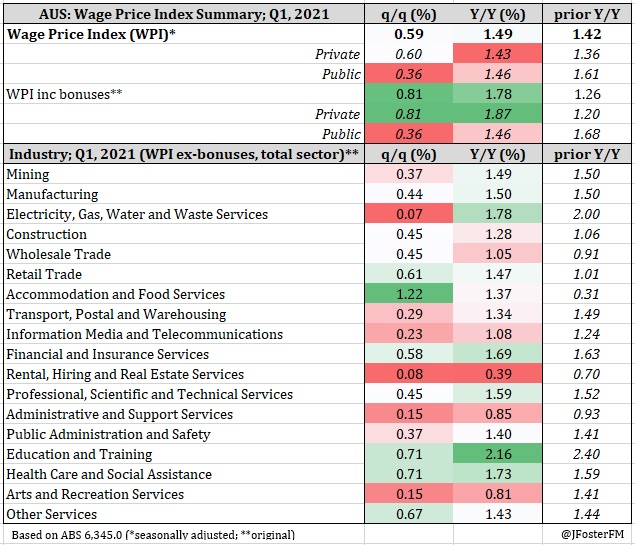Australia's Wage Price Index came in a little above market estimates rising by 0.6% in the March quarter, lifting the annual pace off record lows to 1.5%. Wages growth in the quarter was boosted by temporary factors, namely from the further removal of wage reductions and freezes implemented earlier on in the pandemic and from a delayed minimum wage rise taking effect pandemic-hit industries. Prior to the pandemic, annual wages growth in Australia was around 2.2% and the slowdown to 1.5% leaves the pace well short of the 3% level the RBA expects is required to meet the inflation target.
- The headline WPI (total hourly rates of pay ex-bonuses) came in a touch stronger than expected rising by 0.59% in the March quarter against the consensus estimate for a 0.5% lift.
- Wages growth through the year to Q1 2021 ticked up to 1.49% from 1.42%, continuing the grind higher off the record lows in the September quarter (1.36%) in the fallout from the pandemic.
Wage Price Index — Q1 | The details
Reflecting these developments, growth in private sector wages lifted by 0.6% in the March quarter outpacing the 0.36% lift in public sector wages, with widespread wage freezes restraining growth in the latter. Through-the-year growth in private wages ticked a little higher to 1.43% from 1.36%, though this compares with a pre-pandemic pace of around 2.2%. While growth in private sector wages is now starting to lift (albeit slowly) off record lows, public sector wages slowed to a new series low of 1.46%Y/Y. Prior to the pandemic, annual growth in public sector wages was slightly stronger than in the private sector.
Looking across the industries, accommodation and food services saw the strongest quarterly increase (1.22%), reflecting the boost from the minimum wage increase. Similarly, this also helped lift wages growth in other pandemic-hit industries, though at more modest rates of increase: retail 0.61%q/q and other services (including tourism services) 0.67%q/q. Wages across business services was more contained in Q1 (0.37%) after recording a stronger increase in the December quarter (0.8%) as wages started to return to more normal levels with temporary cuts and freezes unwinding. The underlying moves reflected this with quarterly growth slowing in professional services (0.45% in Q1 from 1.21% in Q4), administration (0.15% from 0.86%), real estate services (0.08% from 0.39%) and information media (0.23% from 0.61%), though it advanced in finance and insurance (0.58% from 0.15%). Growth in wages in the health industry lifted by 0.71% in Q1, elevating the pace through the year to 1.73%. Education and training also posted a 0.71% rise in the quarter, with annual growth strongest of all industries at 2.16%. Aside from education and training, annual wages growth remains a long way from pre-pandemic levels in all other industries as the chart below shows (click to expand).
For the states, annual wages growth is running around at around a 1.5% pace, though it is noticeably stronger in Tasmania at 2.0%. There, the key driver is the public sector, with annual wages growth of around 3.0% being the strongest in the nation for all sectors and states.
Wage Price Index — Q1 | Insights
Slow wages growth remains in Australia. While the headline WPI index has moved off its record lows, it took a combination of firms unwinding wage restraints and legislated minimum wage increases to get there. All in all, the labour market needs to be considerably tighter to generate meaningful wages growth. While there are some concerns around labour shortages in certain industries and this may prompt wages to adjust higher, this is not widespread. Despite a strong recovery in the labour market and forward-looking indicators indicating it has further to run, official forecasts from both the RBA and Treasury point to wages growth only grinding higher over the next couple of years.






